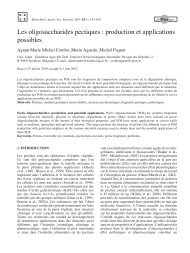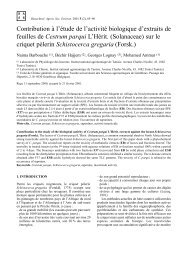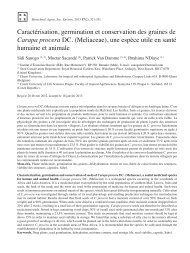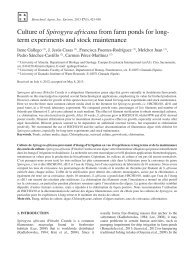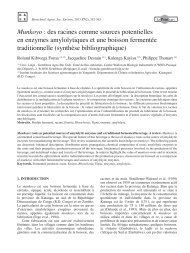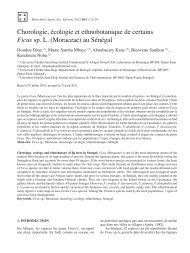Texte PDF - Les Presses agronomiques de Gembloux
Texte PDF - Les Presses agronomiques de Gembloux
Texte PDF - Les Presses agronomiques de Gembloux
Create successful ePaper yourself
Turn your PDF publications into a flip-book with our unique Google optimized e-Paper software.
310 Biotechnol. Agron. Soc. Environ. 2007 11 (4), 299–311 Dagno K., Lahlali R., Friel D., Bajji M., Jijakli MH.Diarra C. (1997). La jacinthe dʼeau Eichhornia crassipes(Mart.) Solms, un danger pour les cours dʼeau duMali. Mali. CILSS, Bulletin bimestriel <strong>de</strong> lʼInstitut duSahel. Sahel IPM. 13, p. 3.El Zawahry MM., Kamel MM. (2004). Removal of azoand anthraquinone dyes from aqueous solutions byEichhornia crassipes. Water Res. 38, p. 2967–2972.Emilio M. (2003). Development, registration andcommercialization of microbial pestici<strong>de</strong>s for plantprotection. Int. Microbiol. 6, p. 245–252.EPA-US. (1988). Design manuel-constructed wetlands andaquatic systems for municipal wastewater treatment.Cincinnati, OH: U.S. Environmental ProtectionAgency. Office of Research and Development, 83.Report n°EPA/625/1-88/022.Evans HC., Ree<strong>de</strong>r RH. (2001). Fungi Associated withEichhornia crassipes (Water Hyacinth) in the upperamazon basin and prospects for their use in BiologicalControl. In Julien MH, Hill MP., Center TD.,Jianqing D. (eds). Biological and integrated controlof water hyacinth, Eichhornia crassipes. Canberra,Australia: Australian Centre for InternationalAgricultural Research. ACIAR Proceeding 102.FAO (1997). Lutte intégrée contre la jacinthe dʼeau etautres plantes aquatiques nuisibles. Rome : FAO:Document <strong>de</strong> Projet n° TCP/MLI 66/13 A.FAO (2000). Water weeds management in West Africa/Ghana water bodies. Rome : FAO: Document <strong>de</strong>Projet n° TCP/RAF/0066.Fayad YH., Ibrahim AA., El-Zoghbyet AA., Shalaby FF.(2001). Ongoing activities in the biological controlof water hyacinth in Egypt. In Julien MH., Hill MP.,Center TD., Jianqing D. (eds). Biological andintegrated control of water hyacinth, Eichhorniacrassipes. Canberra, Australia: Australian Centrefor International Agricultural Research. ACIARProceeding 102.Ghabbour EA., Davies D., Lam YY., Vozzella ME.(2004). Metal binding by humic acids isolated fromwater hyacinth plants (Eichhornia crassipes [Mart.]Solm-Laubach: Ponte<strong>de</strong>riaceae) in the Nile Delta,Egypt. Environ. Pollut. 131, p. 445–451.Gopal B. (1987). Water hyacinth. Amsterdam, TheNetherlands: Elsevier, 471 p.Gowanloch JN., Bajkov AD. (1948). Water hyacinthprogram. Louisiana Department of Wildlife andFisheries. Biennial Report. 2, p. 66–124.Gracia GJA., Fravel DR., Bailey BA., Hebbar PK. (1998).Dispersal of formulations of Fusarium oxysporumf.sp. erythroxyli and F. oxysporum f. sp. melonis byants. Phytopathology 88, p. 185–189.Greaves MP., Holloway PJ., Auld BA. (1998).Formulation of microbial herbici<strong>de</strong>s. In Burges HD.(ed). Formulation of microbial biopestici<strong>de</strong>s, benefi cialmicroorganisms, nemato<strong>de</strong>s and seed treatments.London: Kluwer Aca<strong>de</strong>mic, p. 203–233.Grey WE., Quimby PCJR., Mathre DE., Young JA.(1995). Potential for biological control of downy brome(Bromus tectorum) and medusahead (Taeniatherumcaput-medusae) with crown and root rot fungi. WeedTechnol. 9, p. 362–365.Gutiérrez LE., Arreguín F., Huerto R., Saldaña P. (1994).Aquatic weed control. Int. J. Water Resour. Dev. 10,p. 291–312.Gutiérrez LE., Huerto DR., Martínez JM. (1996). Waterhyacinth problems in Mexico and practiced methodsfor control. In Charudattan R., Labrada R., Center TD.,Kelly-Begazo C. (eds). Strategies for water hyacinthcontrol. Report of a panel of experts meeting, 11-14 September, 1995. Fort Lau<strong>de</strong>rdale, Flori<strong>de</strong>, USA.Rome : FAO, p. 125–135.Harley KLS. (1990). The role of biological control in themanagement of water hyacinth, Eichhornia crassipes.Biocontrol News Inf. 11, p. 11–22.Harley KLS., Julien MH., Wright AD. (1997). WaterHyacinth: A tropical world wi<strong>de</strong> problem and methodsfor its control. Proceedings of the fi rst meeting of theInternational Water Hyacinth Consortium, 18-19 March.Washington: World Bank.Hill G., Waage J., Phiri G. (1997). The water hyacinthproblem in tropical Africa, Proceedings of the fi rstmeeting of the International Water Hyacinth Consortium,18–19 March. Washington: World Bank.Holm LG., Plucknett DL., Pancho JV., Herberger JP.(1977). The worldʼs worst weeds: distribution andbiology. Honolulu: University Press of Hawaï, 609 p.Jayaweera MW., Kasturiarachchi JC. (2004). Removal ofnitrogen and phosphorus from industrial wastewatersby phytoremediation using water hyacinth (Eichhorniacrassipes (Mart.) Solms). Water Sci. Technol. 50 (6),p. 217–225.Klein TA., Auld BA. (1995). Evaluation of Tween 20 andglycerol as additives to mycoherbici<strong>de</strong> suspensionsapplied to Bathurst burr. Plant Prot. 10, p. 14–16.Labrada R. (1996). Status of water hyacinth in <strong>de</strong>veloppingcountries. In Strategies for water hyacinth control.Report of a panel of experts meeting 11–14 September,1995. Fort Lau<strong>de</strong>rdale, Florida, USA. Rome : FAO.Maine MA., Duarte MV., Sune NL. (2001). Cadmiumuptake by floating macrophyte. Water Res. 35 (11),p. 2629–2634.Mangabeira PAO., Labejof L., Lampeti A., DeAlmeida AAF., Oliveira AH., Escaig F., Severo MIG.,Silva da C., Saloes D., Mielke M., Lucena ER.,Martinis MC., Santana KB., Gavrilov KL., Galle P.,Levi SR. (2004). Accumulation of chromium in roottissues of Eichhornia crassipes (Mart.) Solms. inCachoeira river-Brasil. Appl. Surf. Sci. 231–232,p. 497–501.Morris MJ., Wood AR., Den BA. (1999). Plant pathogensand biological control of weeds in South Africa: areview of projects and progress during the last <strong>de</strong>ca<strong>de</strong>. In



